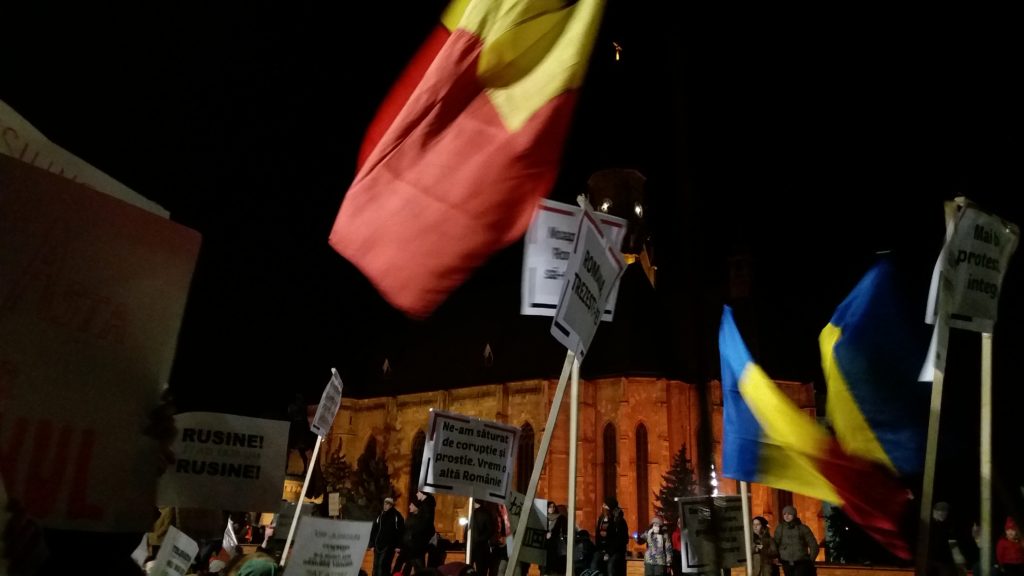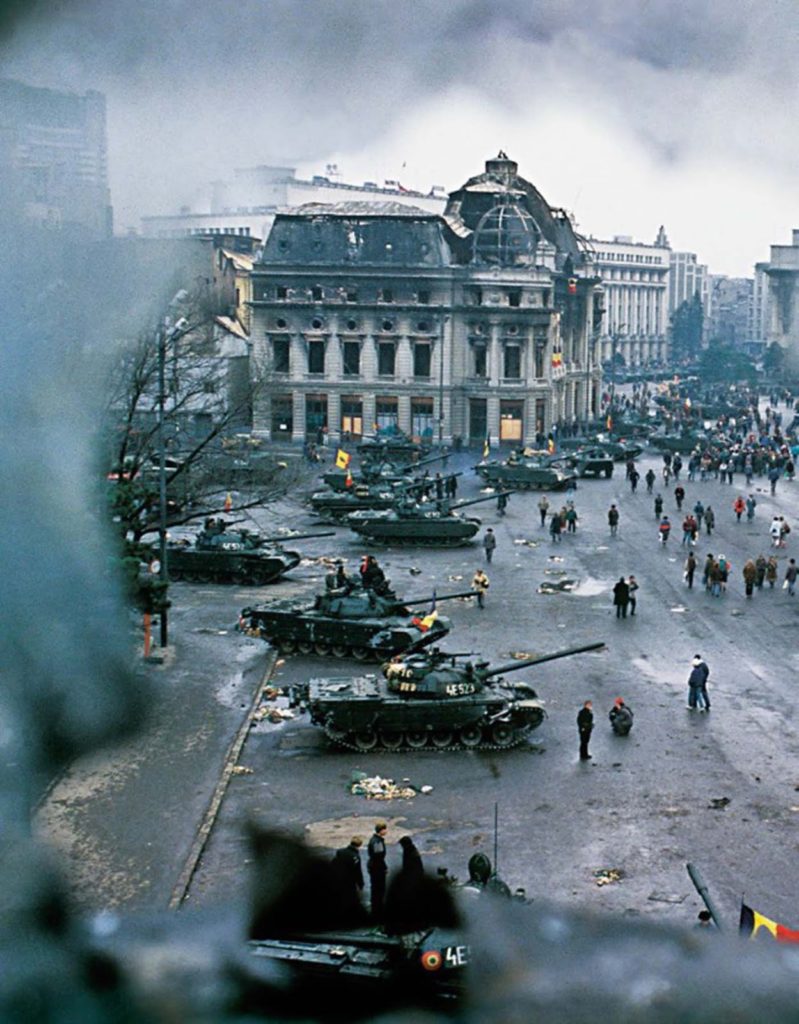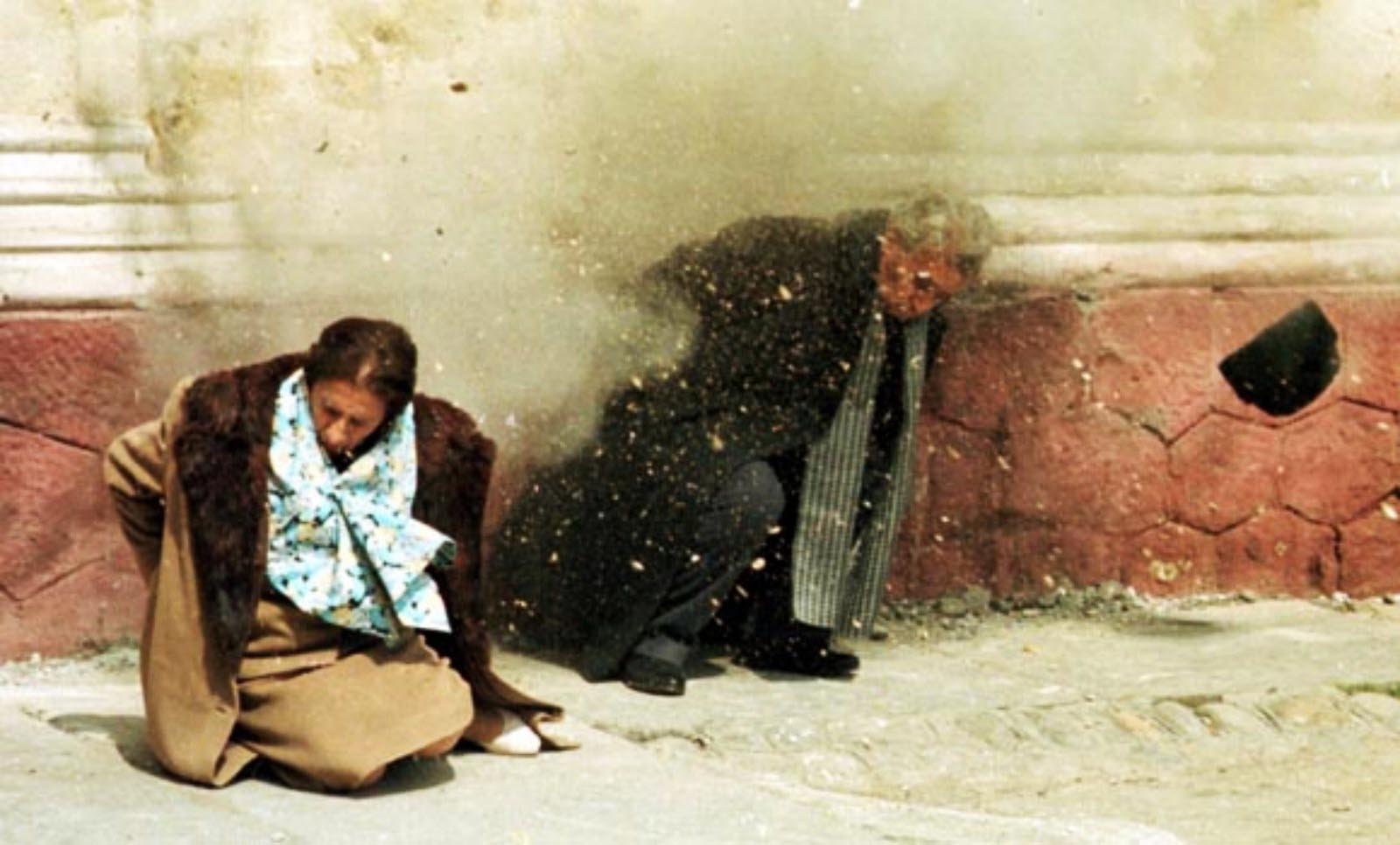Recalling the Romanian Revolution of 1989
Written by Isaiah Winters
Photograph from Wikipedia
At first glance, the Romanian Revolution of 1989 and the Gwangju Uprising of 1980 may seem worlds apart, but in fact, a direct link was forged between the two events in 2013 when the mayor of Timișoara, Romania, visited Gwangju. Mayor Nicolae Robu came to Gwangju as an ambassador for his charming city, which is one of Romania’s tech hubs as well as ground zero for the country’s anti-communist revolution. In an insightful interview with the Gwangju News, Mayor Robu gave an account of his participation in the protests there and how he and his family escaped the shooting by mere minutes. It’s highly recommended reading that ties the spirit of events that took place there with events that occurred here. The Romanian Revolution was a singular affair during the “third wave” of democratization that swept Eastern Europe, and I hope to convey some of its extraordinary facets here.
“Socialism in One Family”
The communist regime of Nicolae Ceaușescu (and his execrable wife, Elena) was probably the most repressive in all of Eastern Europe. Fittingly, the two devoted megalomaniacs, who insisted on being together to the end, reached another superlative milestone when a firing squad executed them in what would later be remembered as the region’s firmest smack of popular revolution. Following the execution, one observer counted 120 bullet casings at the scene.
The Ceaușescus’ hasty and emphatic execution belied the decades of stagnation and grinding authoritarianism endured by the Romanian people. Among the couple’s many draconian edicts was the banning of abortion in order to dramatically increase the population, resulting in overcrowded orphanages and a surge in risky back-alley abortion practices; the severe rationing and exportation of domestic food and energy supplies so as to rapidly pay down the country’s foreign debt; and the allocation of immense national treasure to build the world’s second largest administrative building after the Pentagon, Casa Poporului (the People’s House).
If there was a silver lining to the Ceaușescus’ quarter century in power, it was in the realm of foreign policy. Nicolae became a national hero in 1968 when he stood up to the Soviets by denouncing the Warsaw Pact invasion of Czechoslovakia. Seeking more autonomy from the Soviets, the maverick Nicolae soon began looking abroad for resources and ideas. From Iran, he deftly maintained his country’s oil supply despite the dramatic regime change brought on by the Iranian Revolution. On the other hand, during a trip to the Far East in 1971, he adopted both Mao Zedong’s cult of personality and Kim Il-sung’s Juche as his own and applied them in Romania, with disastrous effect.
Even his wife, Elena, conjured up a cult of personality of her own. Despite her limited education, she was granted many honorary science awards for her plagiarized works on chemistry and was even appointed Deputy Prime Minister of Romania. In fact, it seemed as if the entire Ceaușescu family held high-ranking positions throughout Romania’s vast communist bureaucracy. This caused some Romanians to refer sardonically to the country’s political arrangement as “socialism in one family.” Not surprisingly, by the winter of 1989, Romanians had had more than enough of the Ceaușescus and the decade of austerity they’d ushered in.

Uprising in Timișoara
The unrest began in the far western city of Timișoara on December 16, 1989, when members of Romania’s ethnic Hungarian minority gathered to prevent Pastor László Tőkés from being evicted from his home as punishment for criticizing the government. The number of protesters soon swelled, and their grievances rapidly grew beyond the original issue. With the local police and Securitate (Romania’s secret police) unable to control the increasingly restive crowds, then Timișoara Mayor Petru Moț called in the military and declared martial law. When a crowd of protesters defied the mayor’s orders and waved Romanian flags with the regime’s coat of arms cut from the center, the group was fired upon, leaving many dead and many more wounded. Soon enough, however, the miners and troops who’d been called in to suppress the Hungarians and hooligans supposedly wreaking havoc in Timișoara joined the protesters, as the situation there bore no resemblance to the lies they’d been fed by their superiors. Naturally, news of the uprising in Timișoara spread like wildfire.
The Revolution Will Be Televised
In the middle of all this, the dictator Nicolae left on a pre-planned visit to Iran, leaving the escalating situation in the bumbling hands of Elena and top officials. After just two days abroad, Nicolae returned on December 20 to a country in paroxysms of revolution. He immediately called for a “spontaneous” mass rally the following day so he could address the public in a manner that mirrored his galvanizing speech from 1968. Less than two minutes into his address, however, deafening jeers and boos rose up from the crowd. A befuddled Nicolae faltered in his speech as he gazed out over the sea of defiant faces before him. As directed, the cameraman panned up to the sky, and the live transmission ceased.
For a few unaired minutes, Nicolae and Elena could be heard over the loudspeakers repeatedly imploring the crowd in a scolding and unsettled tone to be still and stay in their places. When order had finally been restored, Nicolae, in a rushed and placatory cadence, breathlessly announced increases in the minimum wage, minimum pension, and child allowance. By the living standards of the day, the increases were rather substantial; however, by attempting to negotiate their own ransom, the Ceaușescus appeared scared and vulnerable. Lacking venality, the crowd – which included many youth born of the anti-abortion decree two decades prior – soon rushed the building, causing the Ceaușescus to flee Bucharest by helicopter. The couple remained on the run for a few days until they were eventually captured, tried, and executed on Christmas Day. When the fighting finally ended, over 1,100 Romanians had lost their lives.

An Arduous Transition
Romania would have a rather rocky transition to democracy following the revolution. “Socialism in one family” had ensured a level of loyalty that severely undermined the formation of any competent opposition within the communist regime. Similarly, the pervasiveness of the Securitate’s network of over a half-million informers prevented the citizenry from organizing any opposition of their own. What’s more, after the revolution, Romania soon adopted a semi-presidential system of government modeled on the French Fifth Republic that gave significant powers to the chief executive.
As a result, Romania’s first president, former communist bureaucrat Ion Illiescu, wielded considerable power that he used to stifle reforms and ensure electoral victories for 11 of the first 15 years following the revolution. Romania consequently developed a flawed “hybrid regime,” a form of democracy that bears some of the formal characteristics of democracy, but that falls short in many other areas. It would take many years for more mature and robust opposition parties to form and challenge the Social Democratic Party (SDP), the successor party to Illiescu’s National Salvation Front.
For the most part, Romania is currently making strides in the right direction. For instance, it’s now a member of both NATO and the EU, and although the regressive SDP is back in power, the people responded at the beginning of 2017 with the biggest nationwide protests since the revolution, something I was fortunate to experience in person. Better yet, on April 17, 2018, Illiescu was indicted for crimes against humanity over his failure to stop the bulk of the revolution’s needless killing, which occurred largely after the Ceaușescus’ had already been ousted from power. Though long in the making, the indictment is something I can raise my glass to all the way from Gwangju: Here’s to many more.
The Author
Originally from Southern California, Isaiah Winters first came to Gwangju in 2010. He recently returned to South Korea after completing his M.A. in Eastern Europe and is currently the new chief proofreader for the Gwangju News. He enjoys writing, political science, and urban exploring.







